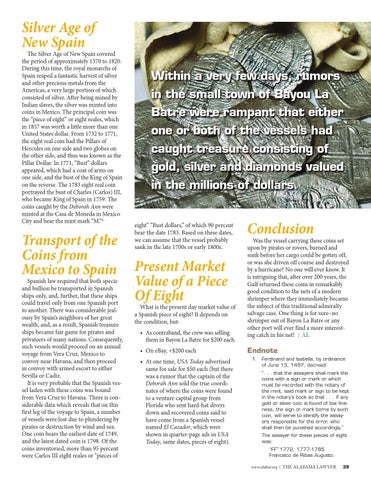Silver Age of New Spain The Silver Age of New Spain covered the period of approximately 1570 to 1820. During this time, the royal monarchs of Spain reaped a fantastic harvest of silver and other precious metals from the Americas, a very large portion of which consisted of silver. After being mined by Indian slaves, the silver was minted into coins in Mexico. The principal coin was the “piece of eight” or eight reales, which in 1857 was worth a little more than one United States dollar. From 1732 to 1771, the eight real coin had the Pillars of Hercules on one side and two globes on the other side, and thus was known as the Pillar Dollar. In 1771, “Bust” dollars appeared, which had a coat of arms on one side, and the bust of the King of Spain on the reverse. The 1783 eight real coin portrayed the bust of Charles (Carlos) III, who became King of Spain in 1759. The coins caught by the Deborah Ann were minted at the Casa de Moneda in Mexico City and bear the mint mark “M.”1
Transport of the Coins from Mexico to Spain Spanish law required that both specie and bullion be transported in Spanish ships only, and, further, that these ships could travel only from one Spanish port to another. There was considerable jealousy by Spain’s neighbors of her great wealth, and, as a result, Spanish treasure ships became fair game for pirates and privateers of many nations. Consequently, such vessels would proceed on an annual voyage from Vera Cruz, Mexico to convoy near Havana, and then proceed in convoy with armed escort to either Sevilla or Cadiz. It is very probable that the Spanish vessel laden with these coins was bound from Vera Cruz to Havana. There is considerable data which reveals that on this first leg of the voyage to Spain, a number of vessels were lost due to plundering by pirates or destruction by wind and sea. One coin bears the earliest date of 1749, and the latest dated coin is 1798. Of the coins inventoried, more than 95 percent were Carlos III eight reales or “pieces of
Within a very few days, rumors in the small town of Bayou La Batre were rampant that either one or both of the vessels had caught treasure consisting of gold, silver and diamonds valued in the millions of dollars.
eight” “Bust dollars,” of which 90 percent bear the date 1783. Based on these dates, we can assume that the vessel probably sank in the late 1700s or early 1800s.
Present Market Value of a Piece Of Eight What is the present day market value of a Spanish piece of eight? It depends on the condition, but: • As contraband, the crew was selling them in Bayou La Batre for $200 each. • On eBay, +$200 each • At one time, USA Today advertised same for sale for $50 each (but there was a rumor that the captain of the Deborah Ann sold the true coordinates of where the coins were found to a venture capital group from Florida who sent hard-hat divers down and recovered coins said to have come from a Spanish vessel named El Cazador, which were shown in quarter-page ads in USA Today, same dates, pieces of eight).
Conclusion Was the vessel carrying these coins set upon by pirates or rovers, burned and sunk before her cargo could be gotten off, or was she driven off course and destroyed by a hurricane? No one will ever know. It is intriguing that, after over 200 years, the Gulf returned these coins in remarkably good condition to the nets of a modern shrimper where they immediately became the subject of this traditional admiralty salvage case. One thing is for sure–no shrimper out of Bayou La Batre or any other port will ever find a more interesting catch in his net! | AL
Endnote 1. Ferdinand and Isabella, by ordinance of June 13, 1497, decreed: “. . . that the assayers shall mark the coins with a sign or mark or which must be recorded with the notary of the mint, said mark or sign to be kept in the notary’s book so that . . . if any gold or silver coin is found of low fineness, the sign or mark borne by such coin, will serve to identify the assayers responsible for the error, who shall then be punished accordingly.” The assayer for these pieces of eight was: “FF” 1772, 1777-1785 Francisco de Ribas Augusto. www.alabar.org | THE ALABAMA LAWYER
39
